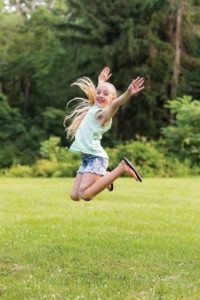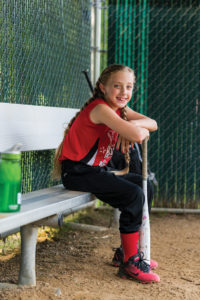By Élan Young
Nine-year-old Michaella Metz twirls, tumbles, runs, flips, skates, climbs, and slides her way through life. She is a softball All Star (at the time of publication, her softball team was 6-0 with four games left) and a competitive dancer. She’s also a left-foot amputee. Although she explores a number of other activities like tumbling, cheerleading, and ice skating, the center of her activities is dancing. This year she began dancing competitively and received the highest score possible in four out of five competitions.
Born with a congenital limb anomaly, Michaella is her parents’ “miracle baby.” Her mother, Maria Pilone Metz, lost Michaella’s twin in utero, and doctors said that Michaella would be born with a limb difference. No one knew what to expect, but with uncertainty came a natural dose of fear.
When baby Michaella arrived, she had a foreshortened left leg with two toes and no foot base. While her mother saw her as nothing but pure perfection, she also wanted Michaella to grow up to experience full mobility. The Metzes were scared, but after seeking out medical specialists, they were led to choose amputation for Michaella’s foreshortened limb when she was 7 months old after considering the range of options. “We wanted to give her the chance to live a full life and do whatever she wanted to do,” says Pilone Metz. “We might have made a different decision if she had had a foot base and more toes, but the amputation has allowed our family to never look back.”
Even while she was healing, Michaella was doing everything that a baby with two legs would do, except she was doing it in a cast. By the end of the next month, she was fitted with a prosthesis, and by 9 months, she was in a gymnastics class for babies. Her parents didn’t tell the teachers she had a prosthesis right away; instead they watched to see how Michaella would do on her own. By the end of the class, they revealed that Michaella is an amputee with a prosthesis, and the teachers were shocked; they couldn’t tell at all. This confidence in Michaella’s innate capability to navigate life as an amputee helped guide the Metzes when it became clear Michaella was in love with dance.

Discovering Dance
The Metzes’ niece, Raffaela—four years older than Michaella—was going to the dance studio, and she let Michaella, who was 2 at the time, wear some outgrown tap shoes. Michaella started tapping around and saying, “Feels good, mama—feels good, mama.” As Michaella tapped all over the house, her mother decided to let Michaella give dance a fair shot.
“As she grew up, one of the things we told her was that anything she wanted to do, we would help her do it,” says Pilone Metz. Since Michaella has not experienced her difference as a physical limitation, she has managed to excel at a number of sports and activities, and her parents are her biggest cheerleaders.
Since the age of 5, Michaella has taken about six or seven dance classes per year.
In school, she has danced every year in the talent show, and afterward people come up to Pilone Metz to talk about what an inspiration her daughter is. It was a natural progression that Michaella decided she wanted to dance competitively.
Proof Is in the Dancing

After being told by the dance instructors that they weren’t sure that Michaella would be able to keep up with the competition, Metz let it go for a year. The next year, Michaella prepped for tryouts with a six-class summer dance session and was partially accepted to the team. While she doesn’t dance with the team, she does dance a solo and is in the team’s production number.
Michaella still works to prove that her amputation isn’t a limitation in the field of dance. This year, she made gains by doing what any driven champion would do—winning all five individual competitions she was in. In four out of five, she received the platinum score, which means she scored 287 or higher out of 300 total points.
“She came home with a trophy that was bigger than her,” says Pilone Metz.
Michaella buckles down to keep practicing—an average of eight hours a week. She does it for the love of it, but she is also motivated to prove that as an amputee she should not be held back. This year showed her that not only can she compete alongside dancers without disabilities, she can actually outperform them.
“She just sees limitations and jumps right over them,” says Pilone Metz. “If you don’t hold your kid back, nothing will hold them back.” The Metzes have let Michaella lead the way to become even more of who she wants to be: one tough and graceful little dancing queen. “She’s in phenomenal shape, and we want to show people that yes, she can do this.”
TOP IMAGE: Image by Catalina Fragoso.



